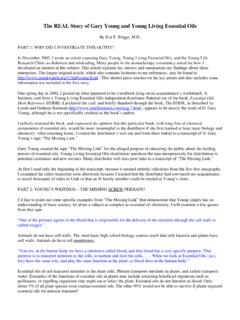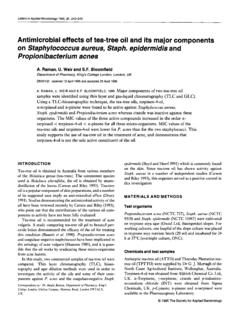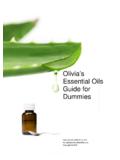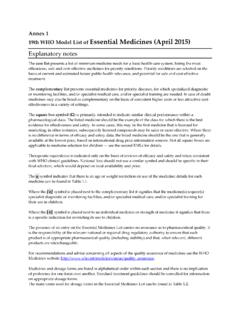Transcription of Chapter 2 Essential Oils Chemistry - Jonn's …
1 19 Springer International Publishing Switzerland 2015D. P. de Sousa (ed.), Bioactive Essential oils and Cancer, DOI Zuzarte ( ) L. SalgueiroFaculty of Pharmacy, University of Coimbra, Coimbra, Portugale-mail: Salgueiroe-mail: 2 Essential oils ChemistryM nica Zuzarte and L gia SalgueiroWhat are Essential oils ? Essential oils , also known as essences, volatile oils , etheric oils , or aetheroleum, are natural products formed by several volatile compounds (Sangwan et al. 2001; Baser and Demirci 2007). According to the International Standard Organization on Essential oils (ISO 9235: 2013) and the European Pharmacopoeia (Council of Europe 2004) an Essential oil is defined as the product obtained from plant raw material by hydrodistillation, steam distillation or dry distillation or by a suitable mechanical process (for Citrus fruits).
2 Cold pressing without heat is usually used for Citrus fruit oils because their constituents are thermosensitive and unstable, con-verting into artifacts under heat and pressure. Moreover, Essential oils are frequently associated with gums and resins that are separated by the distillation process (Baser and Demirci 2007).The definition of an Essential oil excludes other aromatic/volatile products obtained by different extractive techniques like extraction with solvents (con-cretes, absolutes), supercritical fluid extraction, and microwave-assisted extraction. Essential oils also differ from fixed oils or fatty oils in both chemical and physical properties. Fatty oils contain glycerides of fatty acids and leave a permanent stain on filter paper, whereas Essential oils contain volatile compounds and vanish rap-idly without leaving any nature, Essential oils play very important roles in plant defense and signal-ing processes (Harborne 1993; Bowsher et al.)
3 2008; Taiz and Zeiger 2010). For example, Essential oils are involved in plant defense against microorganisms, insects, and herbivores, attraction of pollinating insects and fruit-dispersing ani-mals, water regulation and allelopathic interactions (Fahn 1979; Harborne 1993; 20M. Zuzarte and L. M. SalgueiroPichersky and Gershenzon 2002; Bakkali et al. 2008). Also, they are valuable natu-ral products used as raw materials in many fields, such as pharmaceutical, agro-nomic, food, sanitary, cosmetic, and perfume industries (Buchbauer 2000). Essential oils can be found in various plant organs (flowers, fruits, seeds, leaves, stems, and roots) being produced and stored in secretory structures that differ in morphology, structure, function, and distribution. These specialized structures min-imize the risk of autotoxicity and can be found on the surface of the plant organs or within the plant tissues, being classified as external or internal secretory structures, respectively.
4 Internal secretory structures include secretory cells (often idioblasts), secretory cavities, and secretory ducts whereas external ones include glandular trichomes, epidermal cells, and osmophores (Svoboda and Svoboda 2000). Some plant organs and tissues, such as roots, tubers, and wood, are very hard and need to be broken down to expose the oil-containing cells and cavities for oils are complex mixtures of volatile (around 100 u) to semi-volatile compounds (around 300 u), usually with a strong odor, rarely colored, soluble in or-ganic solvents, and insoluble in water. They comprise volatile compounds of terpe-noid and non-terpenoid origin, synthetized through different biosynthetic routes and with distinct primary metabolic precursors. Terpenoids biosynthesis involves both the mevalonate and non-mevalonate (deoxyxylulose phosphate) pathways, whereas phenylpropanoids are formed via the shikimate pathway (Litchenthaler 1999; De-wick 2002a; Baser and Demirci 2007; Sell 2010).
5 Monoterpenes and sesquiterpenes are usually the main group of compounds found in Essential oils . In addition, phen-ylpropanoids are also very frequent. Moreover, some Essential oils may also contain fatty acids and their esters and, more rarely, nitrogen and sulfur derivatives (Baser and Demirci 2007; Bakkali et al. 2008).In aromatic plants, the composition of Essential oils usually varies considerably because of both intrinsic (sexual, seasonal, ontogenetic, and genetic variations) and extrinsic (ecological and environmental aspects) factors (Figueiredo et al. 2008a; Taiz and Zeiger 2010). Genetic variations may result in the expression of differ-ent metabolic pathways and, consequently, quantitative and qualitative variations in Essential oil composition may occur. When significant differences are found, an intraspecific category (chemotype) is defined.
6 Essential oil quality strongly de-pends on all these factors that may interfere and also limit plant yield. Analytical guidelines published by several institutions such as the European Pharmacopoeia, International Standard Organization (ISO), and World Health Organization (WHO) are available and must be followed to assure the good quality of the commercialized Essential oils and of the plants from which they are obtained. In general, the indus-tries choose the chemotypes that have most commercial interest, in order to obtain high-quality end products as well as efficient biological assessments of Essential oils include sensory evaluations, very common in perfumery houses; physical and chemical tests, required in standards, pharma-copoeias, and codices; and chromatospectral techniques for oil analysis.
7 Hyphen-ation of gas chromatography (GC) separation step with spectroscopic techniques is often required for accurate compound identification, gas chromatography mass spectrometry (GC MS) being one of the most popular hyphenated techniques for 2 Essential oils Chemistry21characterization and identification of complex volatile compounds. A flame ion-ization detector is usually used for quantitative analysis, while a quadropole mass detector or ion-trap detector is necessary to characterize Essential oil constituents (Baser and Demirci 2007). Identification of the compounds is made by comparison of both chromatographic data ( , Kov ts indices and linear retention indices) and mass spectra data with those of authentic samples and library reference spec-tra. Notwithstanding the achievements in analytical techniques, the total separation and identification of all compounds of the volatile mixture remains unattainable because of the large number of compounds, structural similarities, isomeric forms, and concentration range of the compounds present in Essential oils (Gomes da Silva et al.)
8 2008). In this way, similar retention times may occur and confirmation on two columns of different polarity is advised in order to avoid misleading identifications. Taking into account that Essential oils may contain hundreds of constituents, co-elu-tions are inevitable and therefore new analytical strategies have been developed to maximize compound separation, namely multidimensional GC (MD-GC) and com-prehensive two-dimensional GC (GCxGC) (Gomes da Silva et al. 2008). Moreover, compounds with similar mass spectra and identical retention indices make Essential oil characterization a very difficult task. In these cases, other methodologies like GC in tandem with Fourier transform infrared (GC-FTIR) and nuclear magnetic resonance spectroscopy (13C-NMR) should be considered (Gomes da Silva et al.
9 2008; Tomi et al. 1995).Several plant families comprise well-known aromatic species, many of them in-cluded in the Generally Recognized as Safe (GRAS) list fully approved by the US Food and Drug Administration (FDA) and Environmental Protection Agency (EPA, USA) for addition to food and beverages. The major Essential oil bearing plant fami-lies include Apiaceae, a widely distributed group of annual, biennial, and perennial plants, with Essential oils in tubular ducts; Asteraceae, comprising over 30,000 spe-cies of evergreen shrubs, rhizomatous herbs, tuberous perennials, and tree herbs; Cupressaceae, a group of conifers usually resinous trees and shrubs producing es-sential oils within woods; Lamiaceae, a very diverse group of aromatic herbs and shrubs with volatile compounds normally accumulated in glandular trichomes; Lau-raceae, comprising flowering plants and a number of aromatic trees with volatiles present in cells within the bark and wood; Myrtaceae, a highly aromatic group, including several fruit species.
10 Pinaceae, a group of high growing conifers with res-inous aromatic materials with acids, turpentine, and terpenoids; Piperaceae, a small family of flowering plants; Santalaceae with only a few aromatic species of interest; and Zingiberaceae, the ginger family with several aromatic rhizomes (Hunter 2009).Biosynthetic PathwaysIn nature, two main groups of metabolites can be found: primary and secondary metabolites. Primary metabolites are universal compounds, present in all living or-ganisms, and include proteins, carbohydrates, lipids, and nucleic acids. Secondary 22metabolites are found only in some species and are classified as terpenoids, shiki-mates, polyketides, and alkaloids, the first two being the most relevant in Essential oils (Sell 2010). Although terpenoids are more frequent and abundant in Essential oils , certain species contain high quantities of shikimates, namely phenylpropanoids and when these compounds are present, they provide specific odor and flavor to the plants (Sangwan et al.)












